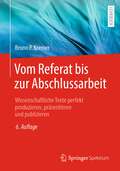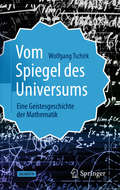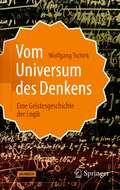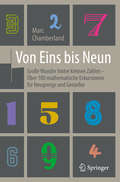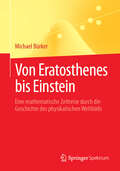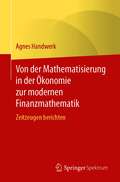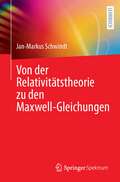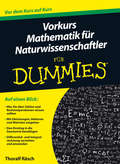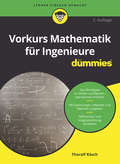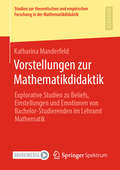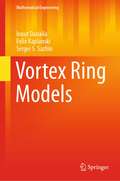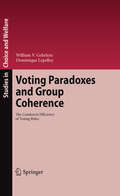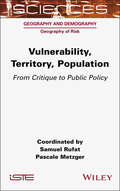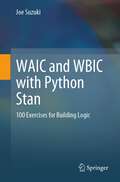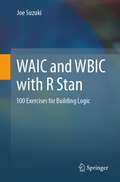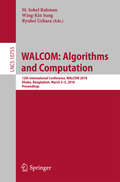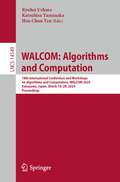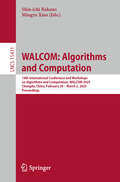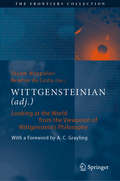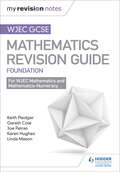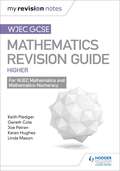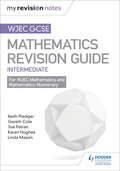- Table View
- List View
Vom Referat bis zur Abschlussarbeit: Wissenschaftliche Texte perfekt produzieren, präsentieren und publizieren
by Bruno P. KremerDiese praxisnahe Anleitung bietet punktgenau dosiert „Erste Hilfe" beim Erstellen schriftlicher Arbeiten im Studium der naturwissenschaftlichen Fächer, aber auch in der gymnasialen Oberstufe oder im Beruf. Der Autor leistet Hilfestellung bei der Suche nach aktuellen Informationen, der Gliederung des Stoffs, beim korrekten Zitieren sowie der Gestaltung von Seitenlayout, Grafiken und Tabellen. Die 3. Auflage wurde überarbeitet und u. a. um einen Abschnitt speziell zur Bachelor-Arbeit ergänzt.
Vom Spiegel des Universums: Eine Geistesgeschichte der Mathematik
by Wolfgang Tschirk«Alle Formeln und Resultate sind fertig, nur den Weg muss ich noch finden, auf dem ich zu ihnen gelangen werde», soll Gauß einmal gesagt haben. Um den Weg, um die vielen Wege zu den Formeln und Resultaten der Mathematik, geht es in diesem Buch. Geboren aus der Lust am Wissen, genährt von der Naturphilosophie, begrenzt nur von den Grenzen des Denkens, stellt die Mathematik dessen Werkzeug und Gegenstand dar. Wir folgen ihren Spuren von der Antike bis in unsere Tage. In acht Kapiteln führt das Buch durch zweitausend Jahre Wissenschaft von den Zahlen, den Figuren, den Gleichungen, von Differential und Integral, vom Zufall, von den Räumen, den Mengen und den logischen Schlüssen.
Vom Universum des Denkens: Eine Geistesgeschichte der Logik
by Wolfgang TschirkLogik ist überall: im vernunftgemäßen Urteil, in der Einsicht, die den Glauben ergänzt, in Sprache und Mathematik, in einer aufgeklärten Ethik und in der Frage nach der Wahrheit und den Grenzen des Wissens. Sie scheint unverzichtbar, selbstverständlich und immer schon da gewesen zu sein, solange Menschen denken. Doch auch die Logik musste erst geschaffen werden – auch sie blickt, wie alle klassischen Wissenschaften, auf ein fünfundzwanzig Jahrhunderte währendes Entstehen zurück, und viele der größten Geister haben an ihr gebaut. Davon berichtet dieses Buch.
Von Eins bis Neun - Große Wunder hinter kleinen Zahlen
by Marc Chamberland Michael BaslerEine Schatztruhe mathematischer MiniaturenDieses Buch ist eine Einladung zu einer spannenden Entdeckungsreise. Ausgehend von den einstelligen Zahlen eröffnet Marc Chamberland seinen Lesern den Blick auf eine weite mathematische Landschaft. Warum zeigt ein Skatspiel, das man achtmal perfekt gemischt hat, wieder genau dieselbe Kartenfolge? Sind zwei beliebige Menschen auf der ganzen Erde tatsächlich über eine „Bekanntenkette von sechs Personen“ miteinander verbunden? Weshalb lässt sich jede Landkarte mit nur vier Farben so einfärben, dass sich nie zwei Gebiete mit derselben Farbe berühren? Die Zahlen Eins bis Neun erweisen sich als höchst bemerkenswerte mathematische Objekte, von denen aus der Autor ein Netz von Querverbindungen zu verschiedenen Feldern der Mathematik spannt, von der Zahlentheorie über die Geometrie, die Chaostheorie und die numerische Mathematik bis zur mathematischen Physik.Jedes Kapitel ist einer dieser neun Zahlen gewidmet. Zu Beginn stehen stets einfache Problemstellungen; im Verlauf des Kapitels nimmt der Schwierigkeitsgrad zu. Jedes Mal durchstreift Chamberland ein weitläufiges Areal: So ist etwa die Drei ebenso mit der Chaostheorie verknüpft wie mit einem noch ungelösten Problem der ägyptischen Brüche, mit der Anzahl der Aufsichthabenden in einer Kunstgalerie und der Problematik von Wahlergebnissen. Bei der Sieben geht es um Matrizenmultiplikation, die Transsilvanienlotterie, die Synchronisation von Signalen und den Klang einer Trommel. Immer wieder sind auch Rätsel zu lösen wie das der perfekten Quadrate, das Huträtsel oder die Catalan‘sche Vermutung. Das Buch ist in viele kurze Abschnitte unterteilt, die man unabhängig lesen und häppchenweise konsumieren kann – was beim Ham-Sandwich-Satz und beim Pizzatheorem durchaus wörtlich genommen werden darf.Mit den über 100 Miniaturen öffnet der Autor eine wahre mathematische Schatztruhe – für Neugierige und Kenner, für Oberstufenschüler wie für Hochschulstudenten, für gestandene Mathematiker ebenso wie für alle, die von Mustern fasziniert sind.
Von Eratosthenes bis Einstein: Eine mathematische Zeitreise durch die Geschichte des physikalischen Weltbilds
by Michael BürkerDer Buchtitel Von Eratosthenes bis Einstein deutet einen großen Bogen an, der in einer mathematischen Zeitreise durchlaufen wird. Das Buch wendet sich an Studierende und an Personen, welche mehr über die Geschichte unseres Weltbilds von der Antike bis zur Gegenwart im Zusammenhang mit den Biografien der Protagonisten erfahren wollen. In der Antike sind dies Denker, welche nach rationalen Ursachen der Naturerscheinungen fragen und rationale Antworten versuchen, und Denker, welche Philosophie, Mathematik und Astronomie zu einer ersten Blüte bringen. In der Renaissance und Neuzeit weisen Kopernikus mit dem heliozentrischen Weltbild sowie Galilei und Kepler mit einer neuen Verknüpfung von Empirie und mathematisch geprägter Theorie den Weg zu naturwissenschaftlichem Denken, vollendet Isaac Newton mit einer tieferen Begründung und Mathematisierung der Physik die kopernikanische Wende und eröffnet gleichzeitig eine Forschungs- und Wissensvielfalt ohnegleichen. Schließlich legen Planck mit der Quantentheorie und Einstein mit den beiden Relativitätstheorien die Grundlagen unseres heutigen Weltbilds, in dem die Urknalltheorie den Beginn unserer Raumzeit vor etwa 14 Milliarden Jahren anzeigt, aber auch die Frage aufkommt, ob hinter der Entwicklung des Universums, wie wir es heute verstehen, eine zielgerichtete Strategie hin zur Existenz des Menschen steckt oder ob diese Entwicklung ein bloßer Zufall äußerst geringer Wahrscheinlichkeit ist.
Von Neumann, Morgenstern, and the Creation of Game Theory
by Robert LeonardDrawing on a wealth of new archival material, including personal correspondence and diaries, Robert Leonard tells the fascinating story of the creation of game theory by Hungarian Jewish mathematician John von Neumann and Austrian economist Oskar Morgenstern. Game theory first emerged amid discussions of the psychology and mathematics of chess in Germany and fin-de-sicle Austro-Hungary. In the 1930s, on the cusp of anti-Semitism and political upheaval, it was developed by von Neumann into an ambitious theory of social organization. It was shaped still further by its use in combat analysis in World War II and during the Cold War. Interweaving accounts of the period's economics, science, and mathematics, and drawing sensitively on the private lives of von Neumann and Morgenstern, Robert Leonard provides a detailed reconstruction of a complex historical drama.
Von der Mathematisierung in der Ökonomie zur modernen Finanzmathematik: Zeitzeugen berichten
by Agnes HandwerkUnterstützt von vielen historischen Dokumenten und Interviews mit Zeitzeugen geht dieses Werk auf ein bedeutsames Thema der Wissenschaftsgeschichte ein: die Entstehung der modernen Finanzmathematik in der zweiten Hälfte des letzten Jahrhunderts.Einführend geht der bekannte Finanzmathematiker Hans Föllmer auf die Entstehungsgeschichte dieser neuen akademischen Disziplin ein und berichtet, wie die neoklassische Wirtschaftstheorie in den 1960er Jahren immer weitere Verbreitung findet und mit ihrer Formalisierung junge Mathematiker anzieht. Dieser zunehmende wissenschaftliche Austausch zwischen Ökonomen und Mathematikern, wegweisend hier eine Gruppe um Werner Hildenbrand an der Universität Bonn, der auch Hans Föllmer angehört, führt zu einer Mathematisierung und damit grundlegenden Änderung der Finanzwissenschaft. Vor allem die Theoriebildung erhält einen enormen Aufschwung, stark unterstützt durch neugegründete Fachzeitschriften, was zu einer Festigung der Finanzmathematik als eigenständige akademische Disziplin führt. Das Buch stellt die Entwicklung dieser modernen Wissenschaft anschaulich, verständlich und anhand vieler Zeitzeugenberichte dar, geht am Ende aber auch auf Grundlagenfragen ein: Schon seit den 1990er Jahren, und dann vor allem nach der Finanzkrise 2008, stellen Wissenschaftler die Frage, ob sich gesellschaftliche Prozesse oder das Verhalten von Akteuren an Finanzmärkten überhaupt korrekt mit Methoden der Naturwissenschaften modellieren lassen.
Von der Relativitätstheorie zu den Maxwell-Gleichungen
by Jan-Markus SchwindtDie Elektrodynamik wird meistens in der historisch orientierten Reihenfolge behandelt, in der das elektrische und magnetische Feld zunächst als separate Objekte eingeführt und schließlich über die Maxwell-Gleichungen miteinander verknüpft werden. Die Lorentz-Symmetrie der Theorie und die Vereinigung der beiden Felder im Feldstärketensor werden üblicherweise erst am Ende gezeigt, obwohl sich die Gleichungen dadurch vereinfachen und sie erst so in allen Bezugssystemen gelten.Damit durchläuft der Studierende zwar die historische Entwicklung, muss aber dann zum Ende der Vorlesung alles rückblickend verstehen und neu einordnen. Dieses Buch geht den umgekehrten, deduktiven Weg, der die Elektrodynamik von vornherein auf das Fundament der Speziellen Relativitätstheorie stellt und von da aus – gegenüber dem üblichen Vorgehen sozusagen "rückwärts" – die bekannten Phänomene und Zusammenhänge ableitet. Dieses Vorgehen erlaubt eine wesentlich straffere und – was die Rolle des Elektromagnetismus im Gesamtzusammenhang der Theoretischen Physik angeht – klarere Behandlung.
Vorkurs Mathematik fur Naturwissenschaftler fur Dummies (Für Dummies)
by Thoralf RäschViele angehende Studenten haben gehörigen Respekt vor der Mathematik, wenn sie ein naturwissenschaftliches Studium beginnen; und das zu Recht. Aber Hilfe naht: Thoralf Räsch bringt Sie, egal wo Sie auf der Schule waren und wo Sie studieren werden, auf den Stand, dass Sie der Mathematikvorlesung im ersten Semester folgen können. Er erklärt Ihnen noch einmal die Grundrechenarten, zeigt, wie man mit Brüchen, Potenzen und Logarithmen rechnet, erläutert komplexe Zahlen, Gleichungen, Vektoren und Matrizen. Er hilft Ihnen, Folgen, Reihen und Funktionen zu verstehen, und unterstützt Sie bei Ihren ersten Schritten in der Geometrie, der Differential- und Integralrechnung. So ist dies das perfekte Auffrischungsbuch vor Ihrem Studium.
Vorkurs Mathematik für Ingenieure für Dummies (Für Dummies)
by Thoralf RäschViele angehende Studenten haben gehörigen Respekt vor der Mathematik, wenn sie ein Ingenieursstudium beginnen, und das zu Recht. Aber Hilfe naht: Thoralf Räsch bringt Sie, egal wo Sie auf der Schule waren und wo Sie studieren werden, auf den Stand, dass Sie der Mathematikvorlesung im ersten Semester folgen können. Er erklärt Ihnen noch einmal die Grundrechenarten, zeigt, wie man mit Brüchen, Potenzen und Logarithmen rechnet und erläutert komplexe Zahlen, Gleichungen, Vektoren und Matrizen. Er hilft Ihnen, Folgen, Reihen und Funktionen zu verstehen und unterstützt Sie bei Ihren ersten Schritten in der Geometrie, der Differential- und Integralrechnung. So ist dies das perfekte Auffrischungsbuch vor Ihrem Studium.
Vorstellungen zur Mathematikdidaktik: Explorative Studien zu Beliefs, Einstellungen und Emotionen von Bachelor-Studierenden im Lehramt Mathematik (Studien zur theoretischen und empirischen Forschung in der Mathematikdidaktik)
by Katharina ManderfeldKonstruktivistische Lerntheorien legen nahe, dass das mathematikdidaktische Lernen von Studierenden abhängig davon ist, welche Vorstellungen sie von Mathematikdidaktik besitzen. Das sich hieraus ergebende hochschuldidaktische Interesse, die studentischen Vorstellungen zur Mathematikdidaktik zu beforschen, wird mithilfe eines Mixed-Methods-Designs umgesetzt. In einer Fragebogenstudie werden Typen unterschiedlicher Vorstellungen gebildet. Mithilfe von Leitfadeninterviews werden anschließend tiefere Einblicke in die Vorstellungen einzelner Vertreterinnen und Vertretern der Typen erlangt. Die Ergebnisse beider Studien werden in vier Vorstellungen zur Mathematikdidaktik zusammengeführt, aus deren Betrachtung Handlungsoptionen zur Verbesserung der hochschulischen Lehre abgeleitet werden können.
Vortex Ring Models (Mathematical Engineering)
by Ionut Danaila Felix Kaplanski Sergei S. SazhinThis book offers a guide to understanding models of vortex rings, starting from classical ones (circular vortex filament, Hill and Norbury-Fraenkel inviscid models) to very recent models incorporating viscous effects and realistic shapes of the vortex core. Unconfined and confined viscous vortex rings are described by closed formulae for vorticity, stream function, translational velocity, energy, impulse and circulation. Models are applied to predict the formation number of optimal vortex rings and to describe two-phase vortex ring-like structures generated in internal combustion engines. The book provides a detailed presentation of analytical developments of models, backed up by illustrations and systematic comparisons with results of direct numerical simulations. The book is useful for graduate students in applied mathematics, engineering and physical sciences. It is a useful reference for researchers and practising engineers interested in modelling flows with vortex rings.
Voting Paradoxes and Group Coherence
by Dominique Lepelley William V. GehrleinThe likelihood of observing Condorcet's Paradox is known to be very low for elections with a small number of candidates if voters' preferences on candidates reflect any significant degree of a number of different measures of mutual coherence. This reinforces the intuitive notion that strange election outcomes should become less likely as voters' preferences become more mutually coherent. Similar analysis is used here to indicate that this notion is valid for most, but not all, other voting paradoxes. This study also focuses on the Condorcet Criterion, which states that the pairwise majority rule winner should be chosen as the election winner, if one exists. Representations for the Condorcet Efficiency of the most common voting rules are obtained here as a function of various measures of the degree of mutual coherence of voters' preferences. An analysis of the Condorcet Efficiency representations that are obtained yields strong support for using Borda Rule.
Vulnerability, Territory, Population: From Critique to Public Policy
by Samuel Rufat Pascale MetzgerDuring the Covid-19 pandemic, the term "vulnerable" was applied to "individuals" and to "populations", "groups" and "countries" in discussions, laws and regulations; now it applies to all objects in relation to all kinds of threats. However, rather than a label for governing people and places, the notion of "vulnerability" was expected to become an instrument to tackle the root causes of disasters, poverty and maldevelopment, as well as the inequalities and injustices they bring, whether social, political, economic or environmental. Despite this radical dimension, vulnerability has gradually been incorporated into public policies and international recommendations for global risk and disaster management. This book is intended for researchers, students, managers and decision makers concerned with the management of not only risks and crises but also climate and environmental change. The first part examines the multiple theoretical and conceptual approaches; the second explores vulnerability assessments, using examples from the Global North and Global South; and the third discusses tools, public policies and actions taken to reduce vulnerability.
WAIC and WBIC with Python Stan: 100 Exercises for Building Logic
by Joe SuzukiMaster the art of machine learning and data science by diving into the essence of mathematical logic with this comprehensive textbook. This book focuses on the widely applicable information criterion (WAIC), also described as the Watanabe-Akaike information criterion, and the widely applicable Bayesian information criterion (WBIC), also described as the Watanabe Bayesian information criterion. The book expertly guides you through relevant mathematical problems while also providing hands-on experience with programming in Python and Stan. Whether you’re a data scientist looking to refine your model selection process or a researcher who wants to explore the latest developments in Bayesian statistics, this accessible guide will give you a firm grasp of Watanabe Bayesian Theory.The key features of this indispensable book include:A clear and self-contained writing style, ensuring ease of understanding for readers at various levels of expertise.100 carefully selected exercises accompanied by solutions in the main text, enabling readers to effectively gauge their progress and comprehension.A comprehensive guide to Sumio Watanabe’s groundbreaking Bayes theory, demystifying a subject once considered too challenging even for seasoned statisticians.Detailed source programs and Stan codes that will enhance readers’ grasp of the mathematical concepts presented.A streamlined approach to algebraic geometry topics in Chapter 6, making Bayes theory more accessible and less daunting.Embark on your machine learning and data science journey with this essential textbook and unlock the full potential of WAIC and WBIC today!
WAIC and WBIC with R Stan: 100 Exercises for Building Logic
by Joe SuzukiMaster the art of machine learning and data science by diving into the essence of mathematical logic with this comprehensive textbook. This book focuses on the widely applicable information criterion (WAIC), also described as the Watanabe-Akaike information criterion, and the widely applicable Bayesian information criterion (WBIC), also described as the Watanabe Bayesian information criterion. This book expertly guides you through relevant mathematical problems while also providing hands-on experience with programming in R and Stan. Whether you’re a data scientist looking to refine your model selection process or a researcher who wants to explore the latest developments in Bayesian statistics, this accessible guide will give you a firm grasp of Watanabe Bayesian Theory.The key features of this indispensable book include:A clear and self-contained writing style, ensuring ease of understanding for readers at various levels of expertise.100 carefully selected exercises accompanied by solutions in the main text, enabling readers to effectively gauge their progress and comprehension.A comprehensive guide to Sumio Watanabe’s groundbreaking Bayes theory, demystifying a subject once considered too challenging even for seasoned statisticians.Detailed source programs and Stan codes that will enhance readers’ grasp of the mathematical concepts presented.A streamlined approach to algebraic geometry topics in Chapter 6, making Bayes theory more accessible and less daunting.Embark on your machine learning and data science journey with this essential textbook and unlock the full potential of WAIC and WBIC today!
WALCOM: 12th International Conference, WALCOM 2018, Dhaka, Bangladesh, March 3-5, 2018, Proceedings (Lecture Notes in Computer Science #10755)
by M. Sohel Rahman Wing-Kin Sung Ryuhei UeharaThis book constitutes the proceedings of the 12th International Workshop on Algorithms and Computation, WALCOM 2018, held in Dhaka, Bangladesh, in March 2018.The 22 full papers presented were carefully reviewed and selected from 50 submissions. The papers cover diverse areas of algorithms and computation, such as approximation algorithms, computational geometry, combinatorial algorithms, computational biology, computational complexity, data structures, graph and network algorithms, and online algorithms.
WALCOM: 18th International Conference and Workshops on Algorithms and Computation, WALCOM 2024, Kanazawa, Japan, March 18–20, 2024, Proceedings (Lecture Notes in Computer Science #14549)
by Hsu-Chun Yen Ryuhei Uehara Katsuhisa YamanakaThis book constitutes the refereed proceedings of the 18th International Conference and Workshops on Algorithms and Computation, WALCOM 2024, held in Kanazawa, Japan, during March 18–20, 2024. The 28 full papers presented in this book, together with two extended abstracts of invited talks, were carefully reviewed and selected from 80 submissions. They cover diverse areas of algorithms and computation, that is, approximation algorithms, algorithmic graph theory and combinatorics, combinatorial algorithms, combinatorial optimization, computational biology, combinatorial reconfiguration, computational complexity, computational geometry, discrete geometry, data structures, experimental algorithm methodologies, graph algorithms, graph drawing, parallel and distributed algorithms, parameterized algorithms, parameterized complexity, network optimization, online algorithms, randomized algorithms, and string algorithms.
WALCOM: 19th International Conference and Workshops on Algorithms and Computation, WALCOM 2025, Chengdu, China, February 28 – March 2, 2025, Proceedings (Lecture Notes in Computer Science #15411)
by Shin-Ichi Nakano Mingyu XiaoThis book LNCS 15411 constitutes the refereed proceedings of the 19th International Conference and Workshops on Algorithms and Computation, WALCOM 2025, held in Chengdu, China, during February 28 – March 2, 2025. The 26 full papers were carefully reviewed and selected from 68 submissions. WALCOM 2025 covered a wide range of topics, including approximation algorithms, algorithmic graph theory and combinatorics, algorithmic and combinatorial aspects of logic, combinatorial algorithms, combinatorial optimization, combinatorial reconfiguration, computational biology, computational complexity, computational geometry, discrete geometry, data structures, experimental algorithm methodologies, graph algorithms, graph drawing, parallel and distributed algorithms, parameterized algorithms and complexity, network optimization, online algorithms, randomized algorithms, and string algorithms.
WITTGENSTEINIAN: Looking at the World from the Viewpoint of Wittgenstein's Philosophy (The Frontiers Collection)
by Shyam Wuppuluri Newton Da Costa“Tell me," Wittgenstein once asked a friend, "why do people always say, it was natural for man to assume that the sun went round the earth rather than that the earth was rotating?" His friend replied, "Well, obviously because it just looks as though the Sun is going round the Earth." Wittgenstein replied, "Well, what would it have looked like if it had looked as though the Earth was rotating?” What would it have looked like if we looked at all sciences from the viewpoint of Wittgenstein’s philosophy? Wittgenstein is undoubtedly one of the most influential philosophers of the twentieth century. His complex body of work has been analysed by numerous scholars, from mathematicians and physicists, to philosophers, linguists, and beyond. This volume brings together some of his central perspectives as applied to the modern sciences and studies the influence they may have on the thought processes underlying science and on the world view it engenders. The contributions stem from leading scholars in philosophy, mathematics, physics, economics, psychology and human sciences; all of them have written in an accessible style that demands little specialist knowledge, whilst clearly portraying and discussing the deep issues at hand.
WJEC GCSE Maths Foundation: Mastering Mathematics Revision Guide
by Karen Hughes Linda Mason Gareth Cole Keith Pledger Joe PetranExam Board: WJECLevel: GCSESubject: MathematicsFirst Teaching: September 2015First Exam: June 2017Maximise your students' grade potential with a step-by-step approach that builds confidence through topic summaries, worked examples and exam style questions- Identify areas of improvement to focus on through diagnostic tests for each topic.- Develop exam skills and techniques with skills-focused exam-style questions and exam advice on common pitfalls.- Build understanding and confidence with clear explanations of each topic covering all the key information needed to succeed.- Consolidate revision with 'two weeks to go' summaries for each topic.
WJEC GCSE Maths Higher: Mastering Mathematics Revision Guide
by Gareth Cole Keith Pledger Joe PetranExam Board: WJECLevel: GCSESubject: MathematicsFirst Teaching: September 2015First Exam: June 2017Maximise your students' grade potential with a step-by-step approach that builds confidence through topic summaries, worked examples and exam style questions.- Identify areas of improvement to focus on through diagnostic tests for each topic.- Develop exam skills and techniques with skills-focused exam-style questions and exam advice on common pitfalls.- Build understanding and confidence with clear explanations of each topic covering all the key information needed to succeed.- Consolidate revision with 'two weeks to go' summaries for each topic.
WJEC GCSE Maths Higher: Mastering Mathematics Revision Guide
by Gareth Cole Keith Pledger Joe PetranExam Board: WJECLevel: GCSESubject: MathematicsFirst Teaching: September 2015First Exam: June 2017Maximise your students' grade potential with a step-by-step approach that builds confidence through topic summaries, worked examples and exam style questions.- Identify areas of improvement to focus on through diagnostic tests for each topic.- Develop exam skills and techniques with skills-focused exam-style questions and exam advice on common pitfalls.- Build understanding and confidence with clear explanations of each topic covering all the key information needed to succeed.- Consolidate revision with 'two weeks to go' summaries for each topic.
WJEC GCSE Maths Intermediate: Revision Guide
by Gareth Cole Keith Pledger Joe PetranExam Board: WJECLevel: GCSESubject: MathematicsFirst Teaching: September 2015First Exam: June 2017Maximise your students' grade potential with a step-by-step approach that builds confidence through topic summaries, worked examples and exam-style questions; developed specifically for the new Mathematics specifications, with leading Assessment Consultant Keith Pledger.- Identify areas of improvement to focus on through diagnostic tests for each topic.- Develop exam skills and techniques with skills-focused exam-style questions and exam advice on common pitfalls.- Build understanding and confidence with clear explanations of each topic covering all the key information needed to succeed.- Consolidate revision with 'two weeks to go' summaries for each topic.
WJEC GCSE Maths Intermediate: Revision Guide
by Gareth Cole Keith Pledger Joe PetranExam Board: WJECLevel: GCSESubject: MathematicsFirst Teaching: September 2015First Exam: June 2017Maximise your students' grade potential with a step-by-step approach that builds confidence through topic summaries, worked examples and exam-style questions; developed specifically for the new Mathematics specifications, with leading Assessment Consultant Keith Pledger.- Identify areas of improvement to focus on through diagnostic tests for each topic.- Develop exam skills and techniques with skills-focused exam-style questions and exam advice on common pitfalls.- Build understanding and confidence with clear explanations of each topic covering all the key information needed to succeed.- Consolidate revision with 'two weeks to go' summaries for each topic.
